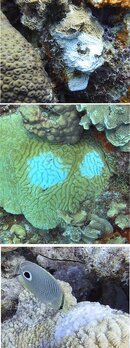wind forecaster
Registered
What would be more likely to spread Stony Corral disease, a diver or a parrot fish?
As a former marine biologist writing beyond my area of expertise, I would guess... Since gloves are not allowed on Bonaire the amount of pathogen spread by diver skin is probably tiny compared to Parrotfish coral sand excrement. But holding on to a living coral with your hand to a living coral is going to kill and damage hundreds of the living polyps and create an entry point for pathogens.
Stressors like temperature, soil runoff and ship pollutants and ocean warming increase vulnerability. Open water spread of a pathogen along island is probably a minor factor given the enormous dilution of the pathogenic spores. More likely the spread from coral to coral on a reef is by very local currents, grazing fish or divers.
We were at Something Special yesterday during the STINAPA survey and they are seeing continued spread of the disease. According to them Bonaire has not seen any long term water temperature changes in the the last decade.
I did notice lots of sponges covered with encrusting algae in the town area. So much algae that damselfish were actually defending the sponge algae crop. Again as a non-expert, I would guess this is due to runoff of household fertilizer from town. Which could be a disease stressor.
I am here on Bonaire for a month installing weather stations that will provide free information to divers, fishermen, windsurfers etc. With practice you can use such sensors to forecast local wind, swell and likely current in picking your dive location. In future months I will be writing blogs about this topic and will mention those on this board
Mike Godsey
weatherflow.com





